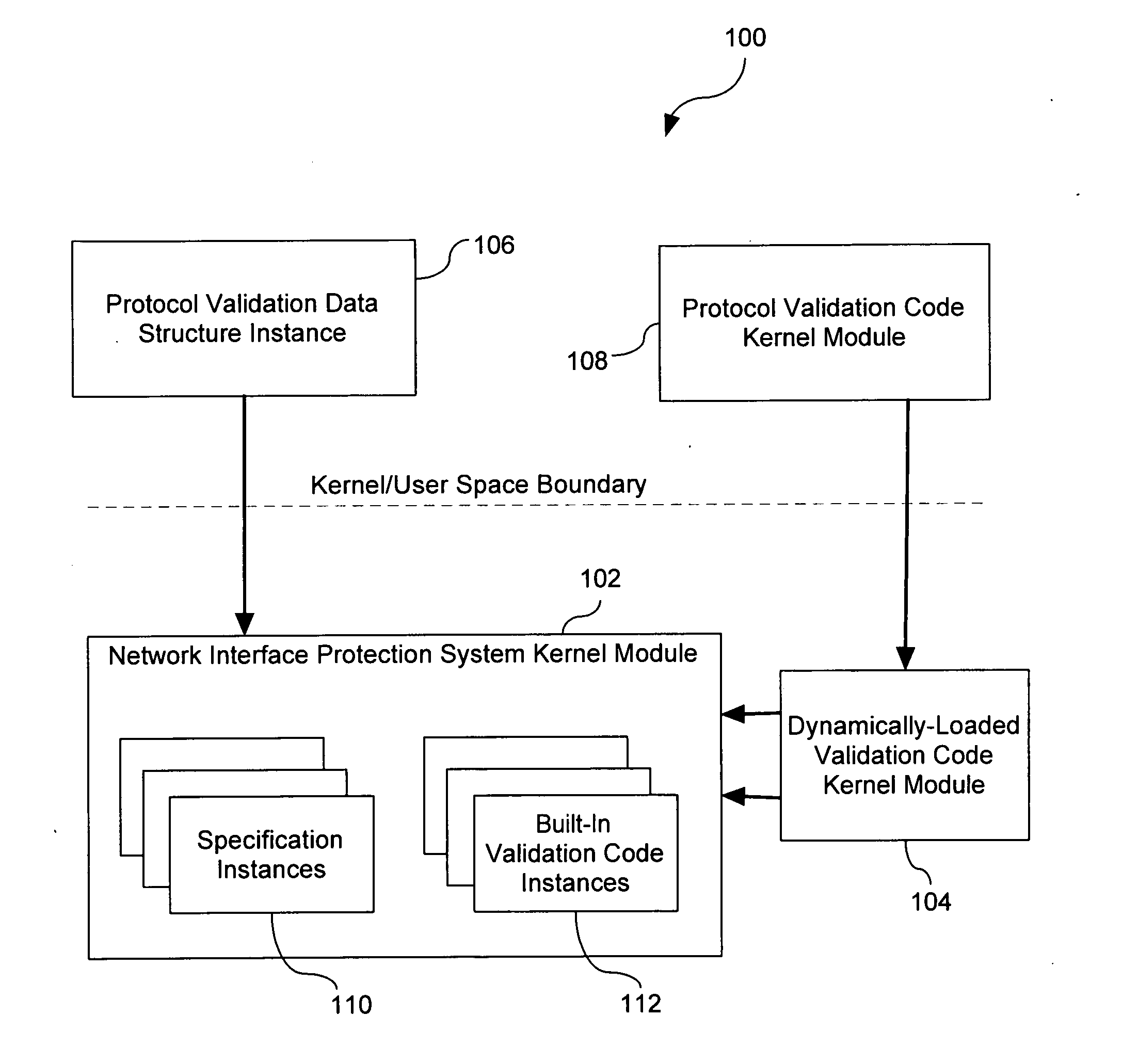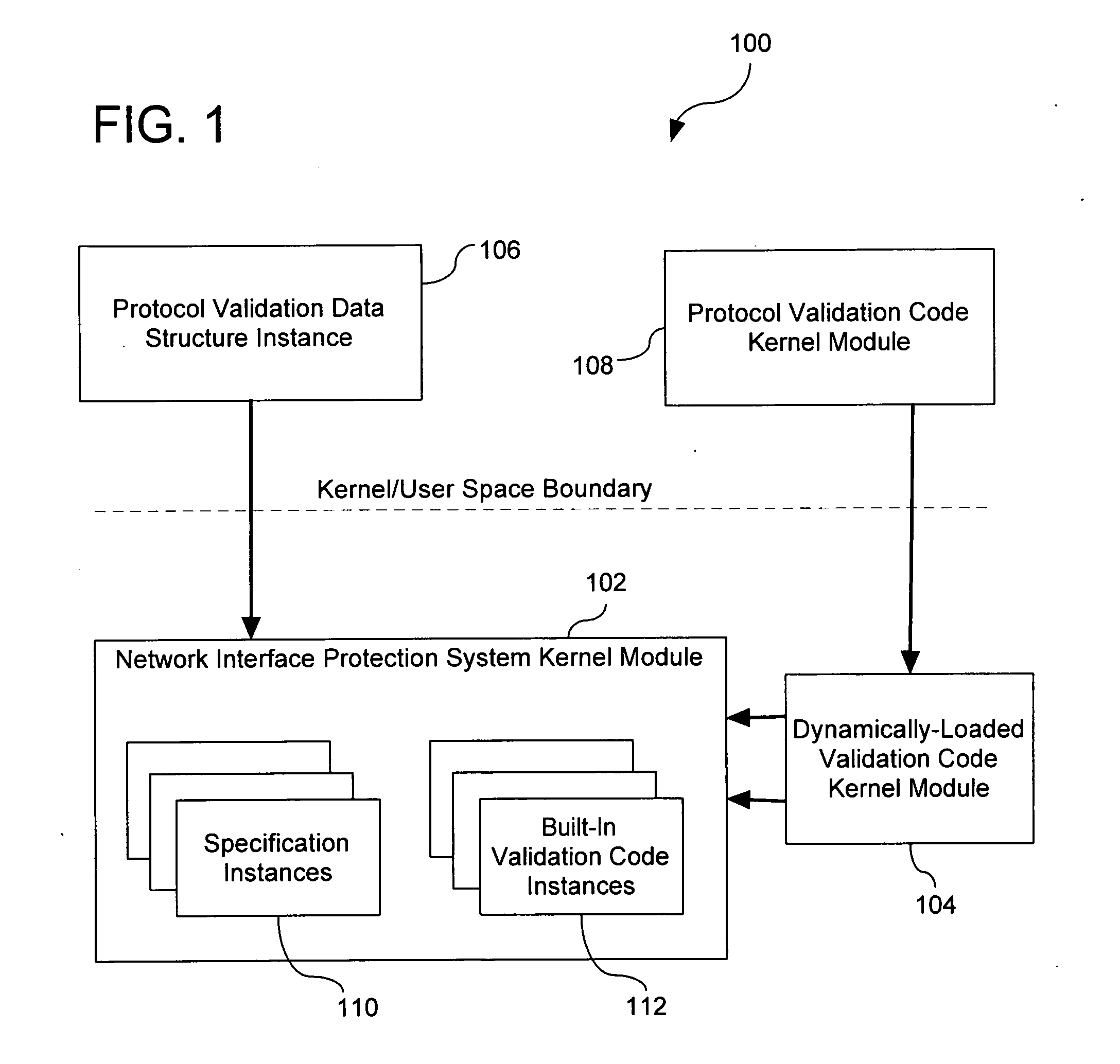Extensible Protocol Validation
a protocol validation and protocol technology, applied in the field of computer network firewalls, can solve the problems of high processor overhead, unpredictable latency and jitter in filtered traffic, and the inability to customize application layer filtering features for particular customers
- Summary
- Abstract
- Description
- Claims
- Application Information
AI Technical Summary
Benefits of technology
Problems solved by technology
Method used
Image
Examples
example 1
Session Initiation Protocol (SIP) in ABNF Language
[0033]
•••Via= ( “Via” / “v” ) HCOLON via-parm *(COMMA via-parm)via-parm= sent-protocol LWS sent-by *( SEMI via-params )via-params= via-ttl / via-maddr / via-received / via-branch / via-extensionvia-ttl= “ttl” EQUAL ttlvia-maddr= “maddr” EQUAL hostvia-received= “received” EQUAL (IPv4address / IPv6address)via-branch= “branch” EQUAL tokenvia-extension= generic-paramsent-protocol= protocol-name SLASH protocol-versionSLASH transportprotocol-name= “SIP” / tokenprotocol-version= tokentransport= “UDP” / “TCP” / “TLS” / “SCTP” / other-transportsent-by= host [ COLON port ]ttl= 1*3DIGIT ; 0 to 255Warning= “Warning” HCOLON warning-value *(COMMAwarning-value)warning-value = warn-code SP warn-agent SP warn-textwarn-code= 3 DIGITwarn-agent= hostport / pseudonym; the name or pseudonym of the server adding; the Warning header, for use in debuggingwarn-text= quoted-stringpseudonym= tokenWWW-Authenticate = “WWW-Authenticate” HCOLON challengeextension-head...
example 2
Simple Network Management Protocol (SNMP) in ASN.1 Language
[0034]
•••GetResponse-PDU ::=[2]IMPLICIT SEQUENCE {request-idRequestID,error-statusErrorStatus,error-indexErrorIndex,variable-bindingsVarBindList}•••
[0035]Modifying a pre-existing (e.g., official version, previously modified version, etc.) of a protocol validation specification to include additional constraints is an example of providing a protocol validation specification (i.e., an enhanced protocol validation specification with respect to the pre-existing version). Such additional constraints can be added as XPath expressions. XPath (XML Path) language is a query language for selecting nodes from an XML document, is based on a tree representation of the XML document, and provides the ability to navigate around the tree for selecting nodes by a variety of criteria. Example 3 below shows an example of XPATH code configured to disambiguate SIP.
example 3
Xpath Code Configured to Disambiguate SIP
[0036]
; Hackery to get RFC 3261 to generate an NFA.not( / / telephone-subscriber)and not( / / pname{ “transport” / “user” / “method” / “ttl” / “maddr” / “lr” })and not( / / srvr / / user-unreserved{ “ / ” / “?” })and not( / / media-range / m-parameter)and not( / / accept-param / generic-param / token{ “q” })and not( / / dig-resp / auth-param / auth-param-name{ “username” / “realm” / “nonce” / “uri” / “response” / “algorithm” / “cnonce” / “opaque” / “qop” / “nc” })and not( / / auth-scheme{ “Digest” })and not( / / infb-param / token{ “icon” / “info” / “card” })and not( / / info-param / generic-param / token{ “purpose” })and not( / / addr-spec / absoluteURI / scheme{ “sip” / “sips” })and not( / / Request-URI / absoluteURI / scheme{ “sip” / “sips” })and not( / / contact-extension / generic-param / token{ “q” / “expires” })and not( / / other-handling{ “optional” / “requred” })and not( / / disp-extension-token{ “render” / “session” / “icon” / “alert” })and not( / / ietf-token{ x-token / “message” / “multipart” })and not( / / ian...
PUM
 Login to View More
Login to View More Abstract
Description
Claims
Application Information
 Login to View More
Login to View More - R&D
- Intellectual Property
- Life Sciences
- Materials
- Tech Scout
- Unparalleled Data Quality
- Higher Quality Content
- 60% Fewer Hallucinations
Browse by: Latest US Patents, China's latest patents, Technical Efficacy Thesaurus, Application Domain, Technology Topic, Popular Technical Reports.
© 2025 PatSnap. All rights reserved.Legal|Privacy policy|Modern Slavery Act Transparency Statement|Sitemap|About US| Contact US: help@patsnap.com



